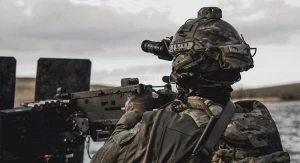
How Ukrainian robotic platforms work and at what distance. Serhiy Zgurets' column
The recap includes the Ramstein-format meeting in Brussels on aid to Ukraine, Russia's deployment of the latest Prometheus system in Crimea, and the use of Ukrainian robotic platforms on the battlefield
Ramstein's results
The United States will provide Ukraine with air defense equipment, armored vehicles, and artillery with ammunition, the US Secretary of Defense said at a regular meeting in the Rammstein format in Brussels. The meeting was attended by representatives of many countries, including Ukraine's Defense Minister Rustem Umerov. The priority issues, as at the last meeting, were to strengthen Ukraine's air defense capabilities, but there were also discussions about training reserves, repairing supplied equipment and other important issues that affect the combat capability of the Ukrainian army.
Lloyd Austin also announced a new $100 million package of American aid. However, there is no definitive information yet on whether the United States will provide Ukraine with a second Patriot battery, which is currently located in Poland. This was previously reported by the American media, and voices in Poland itself began to be heard saying that it is probably not worth transferring this battery to Ukraine, as it will affect the combat capability of Poland itself. So we will wait to see how this story ends.
Explosions in Russia
Ukraine continues systematic measures to destroy Russian S-300 and S-400 air defense systems in Crimea and the temporarily occupied territories, and even in the Belgorod region, using ATACMS and HIMARS. In a few weeks, since mid-April, components of up to a dozen Russian long-range air defense systems, as well as radars and command posts, have been destroyed - all of which, of course, affects the effectiveness of the Russian air defense system and demonstrates the inability of these systems to fight, in particular, the ATACMS, which were still manufactured in the 1980s.
Russia has now moved a piece of equipment from somewhere near Moscow to Crimea - the most modern, according to Russians, S-500 air defense system under the Prometheus index. This was reported by the head of the Defence Intelligence of Ukraine Kyrylo Budanov. This will be its trial, first operation. It can use two types of missiles: one to destroy aircraft, and the other to fight ballistic and even hypersonic missiles. According to the Russian side, the range of this complex with the second missile is claimed to be as much as 500 kilometers, but again, this is advertising data, and only practice is the criterion of truth. It is possible that this complex will have the same fate in the "no analogues" category as the Russian "fifth-generation fighters" Su-57, which were attacked by Ukrainian drones.
Modernized Kh-101
In any case, we must realize that we should not underestimate Russia. It is not as helpless as we would like it to be. There is evidence that the Russians are beginning to use updated cruise missiles to hunt for Ukrainian airfields and aircraft, namely the Kh-101 cruise missile with a new cluster warhead. The Russians have already attacked the airfields in Starokostiantyniv and Vasylkiv with these missiles, which is a sign that the enemy is trying to somehow prepare for the arrival of the long-awaited F-16s. That is why the Ukrainian Air Force needs to provide more cover, using mobile groups, air defense equipment and building hangars for aircraft, as quick adaptation to challenges is important on the battlefield.
Ukrainian robotic platforms at the front
This week, the new Unmanned Systems Forces of the Armed Forces of Ukraine were presented. This structure will be responsible for training, supplying new drones, land, sea, and air-based, and maintaining contacts with manufacturers currently involved in supplying the Armed Forces.
Taras Ostapchuk, a developer of Ukrainian Ratel drones and a serviceman, believes that separate companies should be created for such robotic systems, as was the case with attack UAVs. In particular, a sapper must have new skills, because this work differs from classic mining: "This will significantly reduce the burden on the military and save their lives."
Ostapchuk said that the Ukrainian Defense Forces are currently using four types of robotic platforms on the battlefield: a kamikaze drone, a tow truck, a logistician and a remote miner.
"Each of them systematically receives some kind of update, we respond to feedback from the front line. In fact, the fifth iteration of our robots is currently fighting and the sixth iteration is on the way with improvements. The robotic platforms move the operator away from the contact line and the operator works on average at a distance of 3 km; the logistician and tow truck have now set a record of 30 km away from the operator. Our platforms have been running on Starlink for more than six months. Our operator can be anywhere in the world and control the platform, and 30 km is the range of the power reserve with a load of three people, which is 450 kg," Ostapchuk explained.
The soldier said that these platforms are multifunctional and can carry mines, which makes them kamikaze. The so-called logistician drone can carry up to 400 kg and can withstand the weight of 10 anti-tank mines.
Ratel has direct contracts with military units and is in the final stages of signing a contract with the Ministry of Digital Transformation and the Defense Procurement Agency. Brave1 is helping with this.
"As of today, our main problem is finding people, even though we have funding and three assembly shops. Mobilization does not affect production in any way, we are critical and can book people. People who get to know us come, are interviewed and work for us, but the main problem is the lack of specialization. We employ welders, assistant welders, soldering technicians, electronics engineers, radio technicians, and system administrators. The main problem is the shortage of people and the fact that people are afraid to leave their homes because of mobilization," said the developer of Ukrainian drones.
Ostapchuk said that the company continues to provide training for the military, and about 60 operators have already received additional training. At the same time, the company cooperates with colleagues and exchanges materials and knowledge: "Now all manufacturers are working to win and there is no competition at all. The only issues are scaling, training of operators due to the lack of staff, which is a bit of a slowdown."
According to him, over the past two or three months, Russia has significantly increased the range of robots at the front.
"The robots are much less technologically advanced than ours, just like all their weapons, but they will be 100% large-scale. They have more money and they will have a lot of non-technological robots, much more than we do - the story is the same as with FPV," Ostapchuk explained.
When asked whether the Russians could seize Ukrainian technology and use it in their own country, Ratel, the developer of Ukrainian drones, replied: "In my opinion, they can't, because they can only take the constructive parts, the main issue there is software and communication, and they don't have access to it like NATO and European countries, they will have something primitive from China."
As for the restoration of the robotic platforms, the company is currently working on it on its own. If the malfunction is caused by their mistake, the repair is free of charge for the military, and they also provide kits for on-site repair.
- News













































